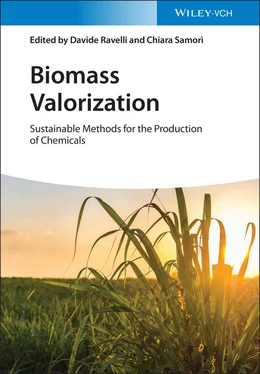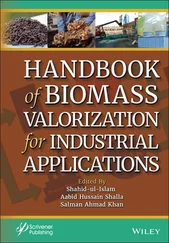Biomass Valorization
Здесь есть возможность читать онлайн «Biomass Valorization» — ознакомительный отрывок электронной книги совершенно бесплатно, а после прочтения отрывка купить полную версию. В некоторых случаях можно слушать аудио, скачать через торрент в формате fb2 и присутствует краткое содержание. Жанр: unrecognised, на английском языке. Описание произведения, (предисловие) а так же отзывы посетителей доступны на портале библиотеки ЛибКат.
- Название:Biomass Valorization
- Автор:
- Жанр:
- Год:неизвестен
- ISBN:нет данных
- Рейтинг книги:3 / 5. Голосов: 1
-
Избранное:Добавить в избранное
- Отзывы:
-
Ваша оценка:
- 60
- 1
- 2
- 3
- 4
- 5
Biomass Valorization: краткое содержание, описание и аннотация
Предлагаем к чтению аннотацию, описание, краткое содержание или предисловие (зависит от того, что написал сам автор книги «Biomass Valorization»). Если вы не нашли необходимую информацию о книге — напишите в комментариях, мы постараемся отыскать её.
Explore the potential of biomass-based chemicals with this comprehensive new reference from leading voices in the field Biomass Valorization: Sustainable Methods for the Production of Chemicals
Biomass Valorization: Sustainable Methods for the Production of Chemicals
Biomass Valorization — читать онлайн ознакомительный отрывок
Ниже представлен текст книги, разбитый по страницам. Система сохранения места последней прочитанной страницы, позволяет с удобством читать онлайн бесплатно книгу «Biomass Valorization», без необходимости каждый раз заново искать на чём Вы остановились. Поставьте закладку, и сможете в любой момент перейти на страницу, на которой закончили чтение.
Интервал:
Закладка:
Through history, a variety of biomass constituents have been employed in the preparation of valuable drugs, flavors, and fragrances, or to provide, especially in the second half of the nineteenth century, commodity materials such as cellulose esters (nitrate and acetate) and oxidized linseed oil (linoleum). Indeed, there exist different options of using biomass to produce chemicals. Nowadays, let apart the use of wood in the paper industry, bio‐based surfactants, lubricants, coatings/dyes, additives for plastics and solvents (mostly based on vegetable oils/animal fats, sugar, or starch) are the most important applications of biomass in chemistry. As for future applications, the question is still open; however, it can be anticipated that the use of biomass for chemicals production is a much more sustainable option than having recourse to it for energetic purposes. Furthermore, in addition to merely duplicating existing products deriving from fossil resources, the chemistry of biomass opens the opportunity to develop a new portfolio of products, having no equivalence among those presently manufactured by classical synthetic routes from hydrocarbons. A subsidiary advantage is that the development of bioproducts requires fewer legislative constraints.
Accordingly, there is an increasing interest in developing suitable techniques to tackle the valorization of biomass to produce chemicals and this area is expected to further expand in the future. Along the same line, bio‐based waste materials, to be included in a circular economy perspective, can likewise contribute significantly. Independently from the actual biomass employed, this is a challenging area because inhomogeneous materials with variable composition must be processed with tailored technologies. The book “Biomass Valorization: Sustainable Methods for the Production of Chemicals” is intended to present the state of the art of the different strategies available nowadays to convert biomass into useful building blocks/commodity chemicals.
Each chapter features an introductory section, detailing the core details of the described technology and showcasing the typical chemical pathways that can be activated by having recourse to it. Next, peculiar advantages and limitations of the described strategy in the processing of biomass are described. Finally, relevant examples from the recent literature are reported, with attention to the organic chemistry perspective, also indicating how the different approaches can modify and valorize the native functionalities present in the starting biomass.
After an introductory section ( Chapter 1), intended to set the stage and describe how biomass can contribute to the production of chemicals, the rest of the book has been organized according to the diverse approaches that can be exploited, also highlighting the potential, challenges, and innovative solutions associated with them. Biomass valorization processes have been explored using catalytic routes, including acid catalysis ( Chapter 2), base catalysis ( Chapter 3), metal catalysis ( Chapter 4), and biocatalysis ( Chapter 5). Various thermal strategies that can be applied for the valorization of biomass involve pyrolysis ( Chapter 6) and thermochemical–biological hybrid processes ( Chapter 7). Different advanced/unconventional strategies have also shown great promise, such as those involving electrochemical ( Chapter 8) and photochemical ( Chapter 9) means, microwave treatment ( Chapter 10), ultrasound‐assisted approaches ( Chapter 11), and mechanochemical approaches ( Chapter 12). As a final contribution, biomass processing from an industrial perspective is assessed ( Chapter 13).
There is no doubt that in the future, the production of chemicals will be based on the exploitation of biomass and the time has come to find the best methods to address this challenge and put it into practice.
November 2020
Chiara Samorì, University of Bologna, Italy
Davide Ravelli, University of Pavia, Italy
1 Role of Biomass in the Production of Chemicals
Layla Filiciotto, Evan Pfab, and Rafael Luque
Universidad de Córdoba, Campus de Rabanales, Departamento de Quimica Organica, Edificio Marie Curie (C‐3), Ctra Nnal IV‐A, Km 396, Córdoba, Spain
1.1 Introduction
Chemistry is a fundamental part of everything around us. Nature is largely responsible for all of the chemistry that occurs and has been so from the dawn of time. However, societal advances and technological developments in recent years have allowed us to contribute far more chemistry than in the past. Quality‐of‐life improvements for major parts of the world with better food distribution, clothing, technological devices, and medical treatments have required the chemistry to progress further with detrimental unknown effects on the environment. Policies and scientists worldwide are now striving toward the development of a truly sustainable society, culminating into the implementation of the UN's 17 Sustainable Development Goals that tackle various issues including infrastructures, education, equality, peace, and environmental protection [1]. In the active search for solutions, biomass valorization has emerged as the most viable option for a more sustainable chemical industry.
The impact that sustainability could have on the chemical industry is best reflected in the magnitude of the chemical industry itself. Today, the chemical industry generates approximately $4 trillion in global sales with the production of more than 95% of all commodities [2]. One of the biggest turning points in the chemical industry, and what arguably led it to such heights, was the advent of catalytic cracking in the nineteenth century for the refining of fossil resources. Catalytic cracking allowed for most of the products we use daily to be easily sourced from petroleum [3]. Biomass valorization processes were also being explored around the same time. However, the complex nature of biomass and the wide availability of fossil resources gained all of society's attention on the use of the latter [4]. As such, petroleum processes have been the major focus of scientists and engineers for the past two centuries. Although significant developments have been achieved considering this with higher resource efficiency and cleaner technologies, the resulting environmental concerns driven by the emissions and spills have led much attention back to renewable processes such as biomass valorization.
Biomass valorization and more sustainable practices are important steps for overturning the “disposable society” mindset where resources are viewed as infinite, cheap, and harmless. One of the most straightforward examples of this can be seen with plastic. Advances in chemistry not only created plastics but also helped notice the alarming consequences.
Plastics were developed in conjunction with the advent of petroleum processes. Plastic products possess desirable characteristics (lightweight, durable, etc.) that allow for endless applications at a low manufacturing cost. Plastics found their way into daily use with things such as clothing and packaging. However, we were unequipped to properly handle this new technology. The characteristics that make plastic so appealing for a wide variety of applications (i.e. durable and heat resistant) are the same that make plastic so difficult to deal with. Its inherent non‐degradability, along with extremely careless handling and littering, created a plastic waste crisis with the now widespread problem of microplastics in our oceans [ 5, 6]. Biomass is a more attractive feedstock that can create bio‐based and/or biodegradable plastics to help overturn the drastic impact from petroleum‐based products. Much initial research has focused on using biomass for drop‐in solutions, i.e. plastics with the same composition and properties as the traditional ones (e.g. polyethylene [PE] and polyethylene terephthalate [PET]). However, the process chemistry limits the efficiency to sugars. On the other hand, other bio‐based plastics with new properties have been developed, e.g. polyethylene furanoate (PEF) or poly‐lactate (PLA). The former is a durable plastic based on furan and the latter a compostable plastic. Developing bio‐based plastics that are also biodegradable – a fundamental challenge in biomass valorization – can ensure a higher sustainability at the waste management stage, as their waste is less dangerous to animals and humans (microplastics, trapped in fishing nets). However, differentiation in the lifetimes of plastics will also require the development of durable bioplastics.
Читать дальшеИнтервал:
Закладка:
Похожие книги на «Biomass Valorization»
Представляем Вашему вниманию похожие книги на «Biomass Valorization» списком для выбора. Мы отобрали схожую по названию и смыслу литературу в надежде предоставить читателям больше вариантов отыскать новые, интересные, ещё непрочитанные произведения.
Обсуждение, отзывы о книге «Biomass Valorization» и просто собственные мнения читателей. Оставьте ваши комментарии, напишите, что Вы думаете о произведении, его смысле или главных героях. Укажите что конкретно понравилось, а что нет, и почему Вы так считаете.












